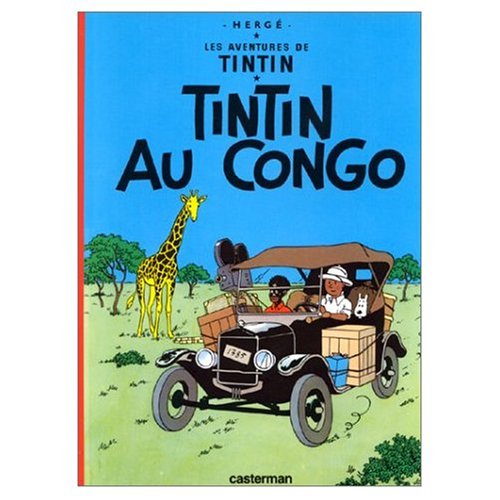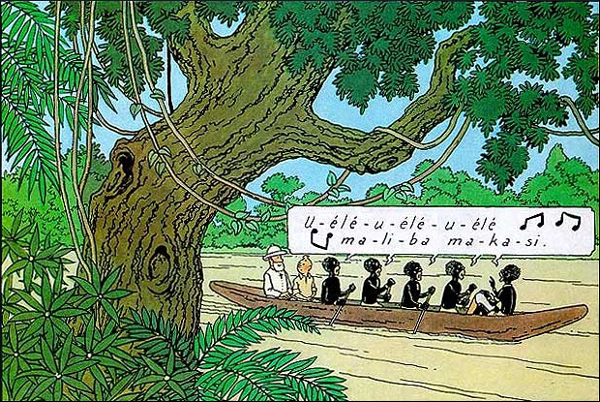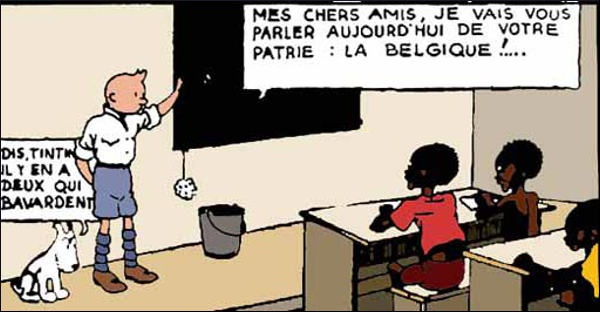
- Tintin au Congo
- Published by: French & European Pubns
- Level: Beginner
- First Published in: 1946
Tintin au Congo was the first graphic novel created by Hergé in 1946. This comic book is very interesting to read nowadays, as it is very much a reflection of Western Europe and its old colonialist understanding of Africa.

Tintin au Congo was the first graphic novel created by Hergé in 1946. This comic book is very interesting to read nowadays, as it is very much a reflection of Western Europe and its old colonialist understanding of Africa. The protagonists are Tintin, a young Belgian reporter, and Milou, his courageous dog. In this world, some animals can talk and others cannot. It’s hard to understand, outside of its comedic effect, why certain animals have the gift of speech. In any case, Milou can talk, and he tells his other canine friends, before he leaves Africa, “J’en avais assez de mener une petite vie monotone,” a pretty snobbish and formal way of saying that he is going to Africa to break the monotony of his life. At other times, Milou barks like a regular dog: “Woah, woah!” is the French onomatopoeic term for barking.
"The reader can get a sense of how Hergé interpreted African people through his drawings. They look like racist caricatures to present-day readers."
The reader can get a sense of how Hergé interpreted African people through his drawings. They look like racist caricatures to present-day readers, with their emphasis on lips and haphazard clothing styles. Additionally, readers might notice the author’s interpretation of the French African accent, with words and phrases like “Missié” (which means “monsieur”), “Toi pas plonger, missié!” (Don’t jump, mister) and “Ça y en a beaucoup de requins par ici!” (There are a lot of sharks around here). Participles are omitted and the pronoun “ça” is used instead of “il .” After Milou is saved from the sharks and he suffers from “psittacose” (parrot disease), both Tintin and Milou can finally enjoy their voyage on deck.

Before they arrive in Congo, we see two tribesmen, a father and son talking about the heroes’ arrival: “Ti vois ce grand bateau Boule de neige?...Eh bien ca y en a Tintin et Milou sur ce bateau.” It is somewhat jarring to read that the son’s name is “Boule de Neige,” or Snowball, since such a name would usually only be given to an animal. It’s also absurd, because there is no snow in Congo. And it’s surprising that these random characters know of Tintin and Milou. Perhaps, this is a Eurocentric view of what matters to Congolese people.
Another startling scene occurs when Tintin accidentally causes a train to derail and, instead of helping the locals undo his mistake, he adopts the role of a boss along with his dog. Milou even shouts, “Tas de parreseux” (Bunch of lazy people) and Tintin exclaims, “Allez-vous vous mettre a l’ouvrage ou non?” (Are you going to get to it or not?). To which one of the local Congolese men retorts, “Mais... mais... va salir moi...” (But, I’m going to get dirty). Hergé underscores the supposed laziness of the Congolese, unwittingly showing a touch of the cruelty of dominating Europeans.
Once the train is fixed, the local tribe “Babaro’m” take himin and say, “Li missié blanc très malin!” (The white man is quite smart). They raise him up to the ranks of a “sorcier” (witch doctor) after he helps them out some more, while the actual witch doctor thinks that Tintin is taking the spotlight away from him. Together with a bandit who has been trying to kill Tintin, these bad guys work together and unsuccessfully try to capture the young Belgian reporter many times.

